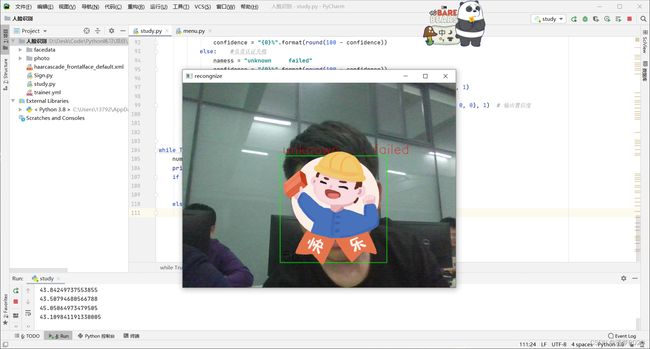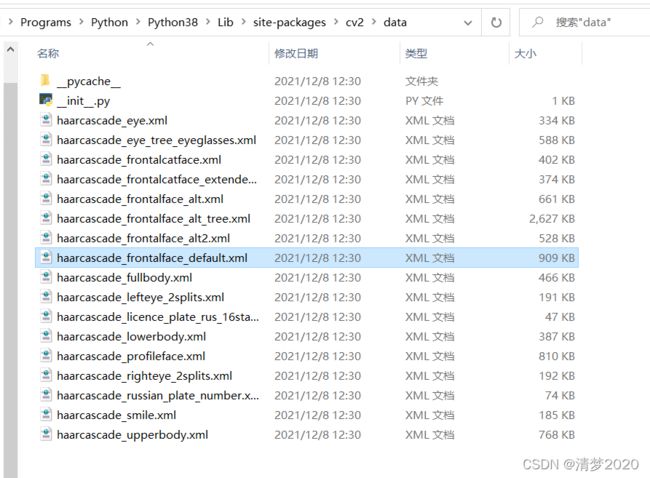人脸识别1.0 python+opencv
实现效果
先上实现效果吧!
录入的人脸识别成功

没录入的人脸显示unknown

菜单功能还比较简易

Opencv安装
CMD中输入
pip install opencv-python
pip install numpy

识别需要用到的文件haarcascade_frontalface_default.xml,在安装opencv-python的时候已经安装了。文件目录一般在
Users\电脑用户名\AppData\Local\Programs\Python\Python38\Lib\site-packages\cv2\data

代码实现
代码注解很详细
import os
from PIL import Image
import cv2
import numpy as np
import time
# 人脸监测初始化 基于Haar级联分类器
face_detect = cv2.CascadeClassifier('haarcascade_frontalface_default.xml')
# 调用默认摄像头
camera = cv2.VideoCapture(0)
#LBP局部二值模式人脸监测
recongnize=cv2.face_LBPHFaceRecognizer()
#如果facedata文件夹不存在,创建一个
def whether_file_exist():
if(not os.path.exists('./facedata')): os.mkdir('./facedata')
def capture(): #录入人脸到facedata文件夹 ,确保文件夹有facedata文件夹
#相机初始化
camera = cv2.VideoCapture(0)
whether_file_exist()
face_name=input("please enter your name!")
print()
face_num=input("please enter your student_id!")
print()
count = 0
print("3秒后即将录入,请正视摄像头")
time.sleep(1)
print("2秒后即将录入,请正视摄像头")
time.sleep(1)
print("1秒后即将录入,请正视摄像头")
time.sleep(1)
while True:
if(count==80) :break
flag, frame = camera.read()
#将图片灰度化,灰度化舍弃了色彩,但是纹理更加清晰,且图片大小更小,便于计算,灰度图像可以用矩阵存储,然后计算,RGB图像是不行的
image = cv2.cvtColor(frame, cv2.COLOR_BGR2GRAY)
#进行多维度监测人脸
faces=face_detect.detectMultiScale(image, 1.3, 5)
#返回出的人脸位置
for x, y, a, b in faces:
#画出正方形
cv2.rectangle(image, (x, y), (x + a, y + b), (0, 255, 0), 1, cv2.LINE_AA)
count+=1
#将捕获的人脸存在facedata文件夹,命名规则为 姓名(英文)+.+ID(随便起一个,但是不能重复,用于后期人脸认证的ID)+.+数字(递增)
#image[y:y+b,x:x+a]
cv2.imwrite("facedata/"+face_name+'.'+face_num+'.'+str(count)+'.jpg', image[y:y+b,x:x+a])
cv2.imshow("row_image",frame)
if cv2.waitKey(1) == ord('q'):
break
camera.release()
# out.release()
cv2.destroyAllWindows()
def face_training(): #将录入的所有人脸进行训练,生成trainer.yml
# 人脸数据路径
path = './facedata'
recognizer = cv2.face.LBPHFaceRecognizer_create()
def getImagesAndLabels(path):
imagePaths = [os.path.join(path, f) for f in os.listdir(path)] # join函数将多个路径组合后返回
faceSamples = []
ids = []
for imagePath in imagePaths:
PIL_img = Image.open(imagePath).convert('L') # convert it to grayscale
img_numpy = np.array(PIL_img, 'uint8')
id = int(os.path.split(imagePath)[-1].split(".")[1])
faces = face_detect.detectMultiScale(img_numpy)
for (x, y, w, h) in faces:
faceSamples.append(img_numpy[y:y + h, x: x + w])
ids.append(id)
return faceSamples, ids
print('数据训练中')
faces, ids = getImagesAndLabels(path)
recognizer.train(faces, np.array(ids))
recognizer.write(r'.\trainer.yml')
def face_identify(): #认证函数
#相机初始化
camera = cv2.VideoCapture(0)
identify=cv2.face.LBPHFaceRecognizer_create()
#让分类器读取原来训练好的数据trainer.yml
identify.read('./trainer.yml')
#学号-姓名字典
names={}
for f in os.listdir('./facedata'):
#f.split('.') 代表着一个文件名 [姓名,ID,count,jpg]
names[f.split('.')[1]]=f.split('.')[0]
while True:
flag, frame = camera.read()
image=cv2.cvtColor(frame,cv2.COLOR_BGR2GRAY)
faces = face_detect.detectMultiScale(image, 1.3, 4)
for x,y,a,b in faces:
cv2.rectangle(frame, (x, y), (x + a, y + b), (0, 255, 0), 1, cv2.LINE_AA)
#用分类器对比认证的人脸与已经录入的人脸,并返回ID和可信度
idnum, confidence = identify.predict(image[y:y + b, x:x + a])
print(confidence)
if confidence < 40: #当可信度大于100-40=60的时候,表示认证成功,经过实测,confidence<40,效果最好
namess = names[str(idnum)]+" suceessful!"
confidence = "{0}%".format(round(100 - confidence))
else: #负责认证失败
namess = "unknown failed"
confidence = "{0}%".format(round(100 - confidence))
#将ID对应的姓名打印在图片上
cv2.putText(frame, str(namess), (x + 5, y - 5), cv2.LINE_AA, 1, (0, 0, 255), 1)
#将可信度打印
cv2.putText(frame, str(confidence), (x + 5, y + b - 5), cv2.LINE_AA, 1, (0, 0, 0), 1) # 输出置信度
#让图片连续起来,没有这个if语句,图片显示会卡住
if cv2.waitKey(1) == ord('q'):
break
cv2.imshow("recongnize",frame)
while True:
num=input("1.录入人脸\n2.监测人脸")
print(num)
if num=='1' :
capture()
face_training()
else :
face_identify()
目前是1.0,只是完成了基本的人脸识别然后认证,后期会加上mysql数据库+PyQt5图形化界面。